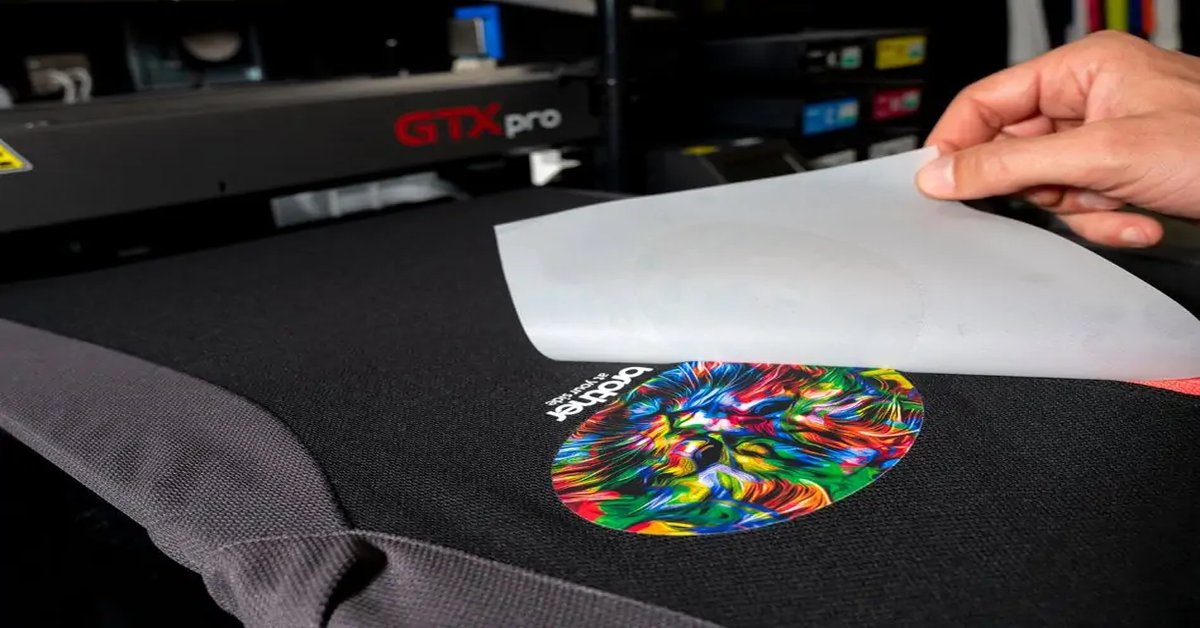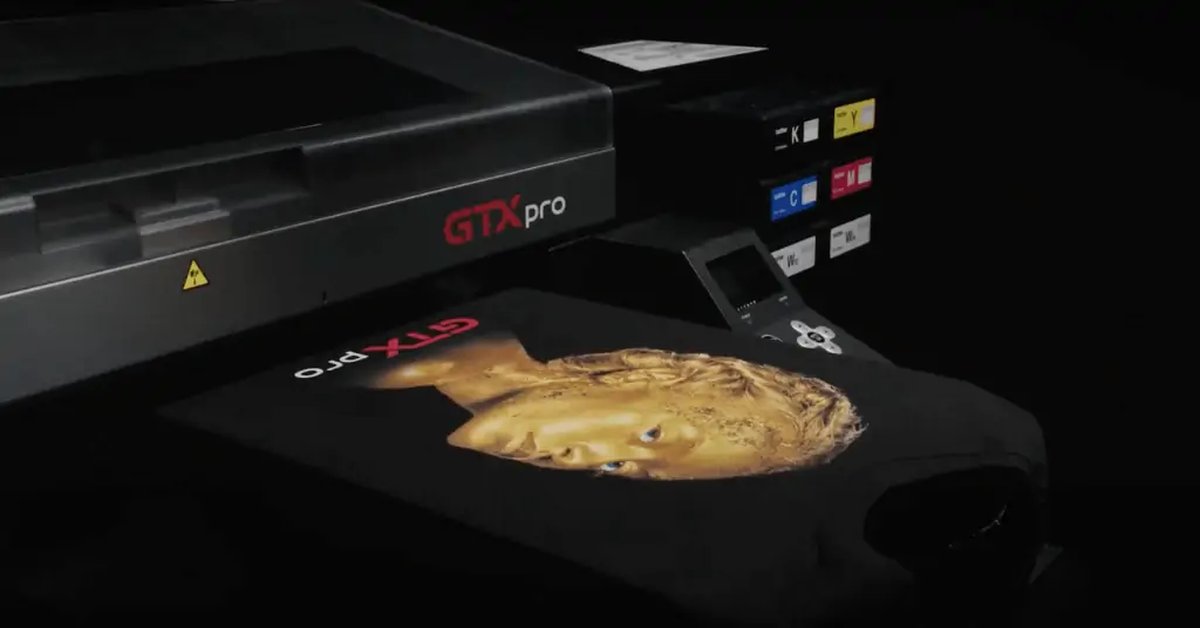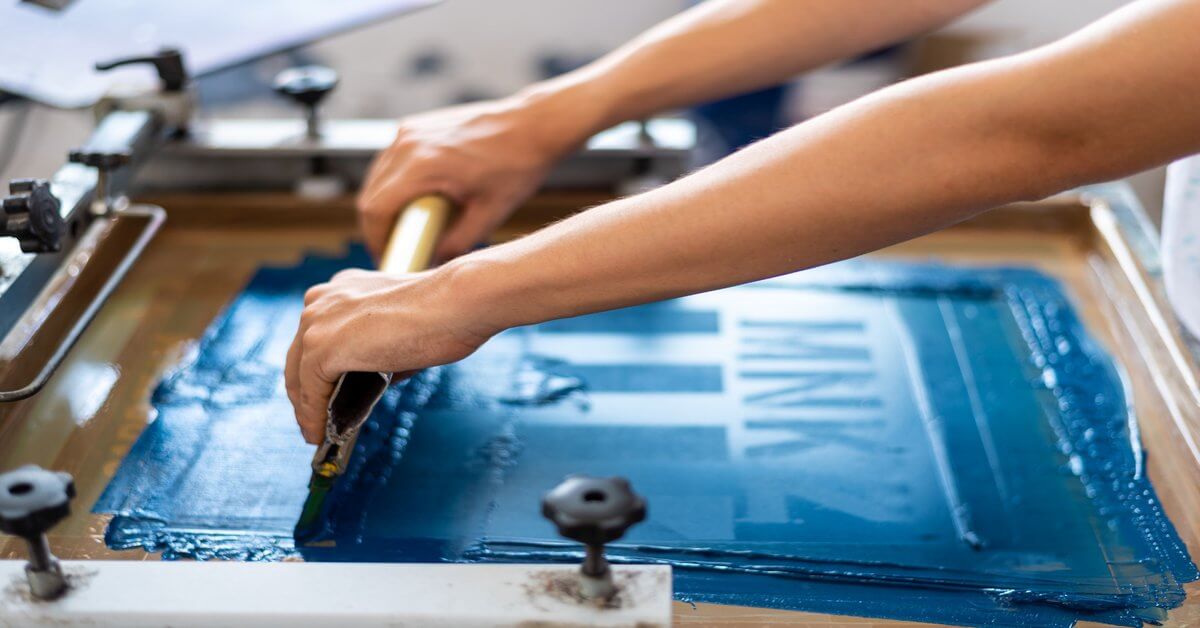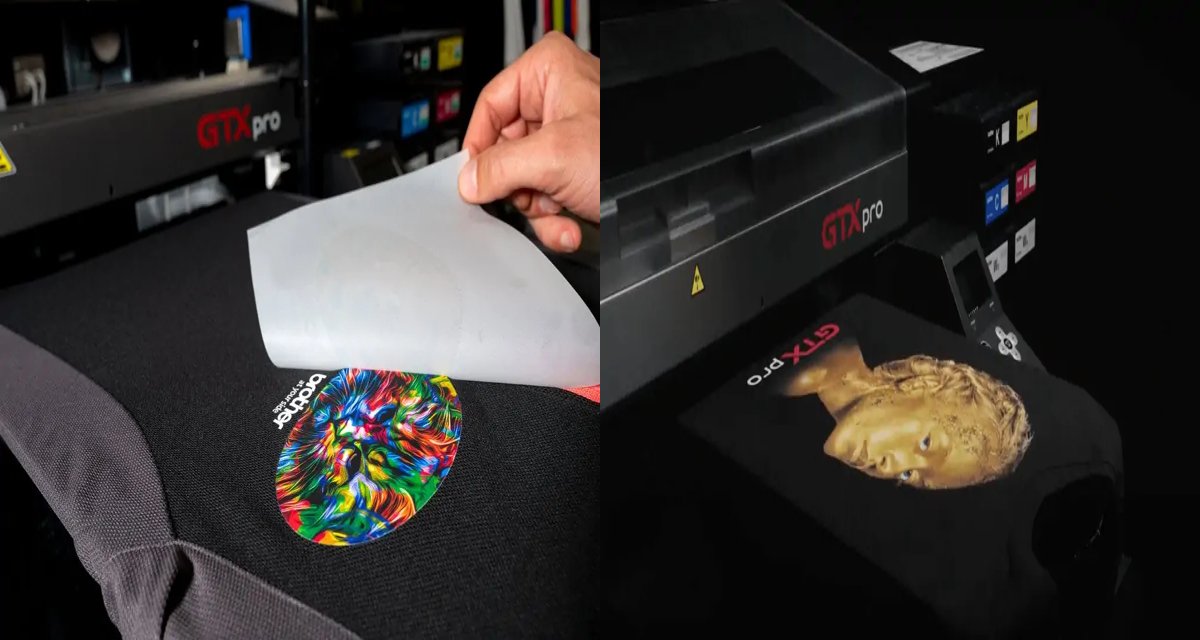Tu carrito está vacío
In order to provide you with a competitive quote, Please send us the following and we’ll get back to you as soon as we can:

Direct to Film (DTF) printing is one of the latest innovations in the textile printing industry, offering a revolutionary way to print on a wide range of fabrics with exceptional color vibrancy and durability. Whether you’re a seasoned printing professional or someone looking to start a custom apparel business, DTF printing has quickly become a game-changer. This guide will provide you with an in-depth look at what DTF printing is, how it works, its advantages and limitations, and everything else you need to know to get started with DTF printing.
Table of Contents:
Direct to Film (DTF) printing is a relatively new technique in garment printing that involves printing designs onto a special film, which is then transferred to fabric using heat and pressure. Unlike Direct to Garment (DTG), which prints directly onto the fabric, DTF allows for greater flexibility as the film can be applied to a variety of materials, including cotton, polyester, blends, and even non-textile surfaces like wood and glass.
The DTF process uses specially formulated inks, typically water-based, along with a powdered adhesive that is applied to the printed design. This adhesive ensures that the design adheres firmly to the fabric during the heat transfer process. DTF printing is praised for its ability to produce vibrant, durable prints that are soft to the touch and resistant to washing and wear.
DTF printing involves a multi-step process that, when followed correctly, results in high-quality, durable designs that can be applied to various substrates. Here's how it works:
Step 1: Preparing the Design
The first step in DTF printing is creating or preparing your design. This design is typically prepared using graphic design software such as Adobe Illustrator, CorelDRAW, or Photoshop. Once the design is ready, it is printed in mirror image onto a special PET (Polyethylene Terephthalate) film using a DTF printer.
Step 2: Printing on PET Film
The DTF printer uses water-based pigment inks designed for use on PET film. The printer applies a white underbase layer of ink first, followed by the colored ink layers. This allows the design to be transferred with vibrant, accurate colors.
Step 3: Applying Adhesive Powder
After the design is printed on the PET film, a powdered adhesive is applied to the wet ink. The adhesive powder is typically made from polyurethane and is responsible for ensuring that the printed design adheres firmly to the fabric once it is heat-pressed.
Step 4: Curing the Design
Once the adhesive powder is applied, the film is heated to cure both the ink and the adhesive. This can be done using a curing oven or heat press, depending on the equipment available. Curing the design ensures that the ink is dry and the adhesive is ready to bond with the fabric during the transfer process.
Step 5: Heat Transfer
After curing, the printed PET film is ready to be transferred onto the fabric. The film is placed onto the garment, and a heat press is used to apply heat and pressure, typically at a temperature of around 300-325°F (150-165°C) for 10-15 seconds. The heat activates the adhesive, causing it to bond with the fabric fibers.
Step 6: Peeling the Film
Once the transfer is complete, the film is peeled away, leaving the printed design firmly attached to the fabric. Some DTF transfers require cold peeling, where the film is left to cool before being peeled off, while others can be peeled hot.
Step 7: Post-Pressing (Optional)
For added durability and a softer feel, a second press can be done after the initial transfer. This involves covering the design with a parchment or silicone sheet and applying heat and pressure for a few seconds. This step is optional but recommended for a smoother finish and enhanced durability.
DTF printing is a relatively new method in the garment printing industry, but it has quickly gained popularity due to its versatility and cost-effectiveness. The technique was developed in response to the limitations of other printing methods like DTG, screen printing, and heat transfer vinyl (HTV).
While DTG printing has been the go-to option for high-quality digital prints, it comes with limitations such as fabric restrictions (works best on 100% cotton) and the need for pre-treatment. DTF printing emerged as a solution that could offer similar high-quality prints without the need for pre-treatment and with greater versatility in fabric options.
As technology advanced, so did the development of DTF inks, printers, and adhesive powders, making the process more efficient, reliable, and accessible for small businesses and DIY enthusiasts. The ability to print on demand, with minimal setup and costs, has contributed to its rapid adoption across the apparel industry.
While both DTF and DTG (Direct to Garment) are digital printing methods, they differ significantly in terms of process, applications, and advantages. Here’s a comparison of the two:
1. Fabric Compatibility
DTG: Works best on 100% cotton or cotton-dominant blends.
DTF: Can be applied to a wide range of fabrics, including cotton, polyester, nylon, silk, and more. DTF can also print on non-textile surfaces like wood, metal, and glass.
2. Pre-Treatment
DTG: Requires pre-treatment of the fabric to ensure the ink adheres properly, especially on dark fabrics.
DTF: No pre-treatment is required, making the process faster and simpler.
3. Durability
DTG: Produces soft, breathable prints but may fade over time if not properly cured or washed.
DTF: DTF prints are highly durable and resistant to cracking, peeling, and fading, making them ideal for garments that undergo frequent washing.
4. Setup Costs
DTG: Requires expensive printers, maintenance, and pre-treatment machines, making it more costly for beginners.
DTF: DTF printers and supplies are generally more affordable, and the process requires less equipment.
5. Color Vibrancy
DTG: Produces vibrant colors but may struggle with dark fabrics without a proper white underbase.
DTF: Offers vivid color reproduction with a white underbase automatically applied during the printing process.
6. Applications
DTG: Best suited for t-shirts and other fabric items.
DTF: Can be used on a wide range of materials, including fabric, wood, glass, and metal, making it more versatile.
Advantages:
Disadvantages:
Now, let’s dive deeper into the step-by-step process of DTF printing, breaking down each phase in more detail.
As with any printing method, the first step is preparing your design. Whether you’re printing a simple logo or a complex, full-color graphic, it’s important to ensure that the design is high resolution (at least 300 DPI) to achieve crisp, clear prints.
For best results, use vector formats such as AI (Adobe Illustrator) or EPS, or high-quality raster formats like PNG and TIFF. You can also use color profiles like RGB for more vibrant results.
Once your design is ready, load it into the DTF printer’s software. The printer will print the design in reverse (mirror image) on the PET film, starting with a white underbase layer of ink, followed by the colored inks.
Ensure that you have enough PET film loaded in the printer and that the print heads are aligned correctly for precise printing. DTF printers usually come with RIP software that manages color profiles, ink usage, and print resolution.
After the design is printed on the PET film, you’ll need to apply a powdered adhesive. The adhesive powder is applied while the ink is still wet to ensure it adheres to the design. You can either manually sprinkle the powder onto the film or use a specialized adhesive shaker to ensure even distribution.
Once the powder is applied, gently shake off the excess powder, making sure that the entire design is coated evenly.
Curing the adhesive powder is the next step in the process. This can be done using a heat press or a curing oven. If using a heat press, hover the heat plate over the PET film (without applying direct pressure) at a temperature of around 300-325°F (150-165°C) for 2-5 minutes. This process melts the adhesive powder, preparing the design for transfer.
Make sure that the ink and powder are fully cured before moving to the next step. Proper curing ensures the durability and adhesion of the final print.
Once the film is cured, it’s ready to be transferred onto the fabric. Place the PET film (with the printed design facing down) onto the garment. Use a heat press set to 300-325°F (150-165°C) and apply pressure for 10-15 seconds.
The heat activates the adhesive, bonding the design to the fabric fibers. For the best results, make sure that the garment is flat and free of wrinkles before pressing.
After heat pressing, let the garment cool for a few seconds (or longer if using a cold peel transfer). Once the film has cooled, carefully peel it away from the fabric, revealing the printed design. Make sure to peel slowly to ensure the design adheres fully to the garment.
If you’re using a hot peel transfer, the film can be peeled immediately after pressing, but caution is required to avoid smudging or lifting the design.
For added durability and a softer finish, you can post-press the garment. Place a parchment paper or silicone sheet over the design and apply heat and pressure for another 5-10 seconds. This helps smooth the print and enhances adhesion, ensuring the design lasts longer through washing and wear.
To achieve the best results with DTF printing, consider the following best practices:
Selecting the right DTF printer is a critical decision that can impact the quality, speed, and cost of your printing process. Here are some key factors to consider when choosing a DTF printer:
Look for printers that offer high-resolution printing capabilities (at least 1440 DPI) for sharp, vibrant images. The quality of the print will depend on the printer’s ability to lay down precise amounts of ink in both the white underbase and color layers.
If you’re planning to produce high volumes of prints, choose a printer that can handle fast printing speeds without compromising quality. Some DTF printers are designed for small-scale production, while others are better suited for large-scale commercial use.
DTF printers use specialized pigment inks, so it’s important to choose a printer with an efficient ink delivery system. Look for printers that use bulk ink systems to minimize costs, and ensure that the inks are formulated for durability and color vibrancy.
DTF printers come in different sizes, from compact desktop models to larger industrial machines. Consider the size of the designs you plan to print and choose a printer that accommodates the width and length of your PET film.
Make sure that the printer you choose is compatible with the design software and RIP (Raster Image Processor) software you use. RIP software is essential for managing color profiles, ink consumption, and print resolution, so ensure it integrates smoothly with your workflow.
Invest in a printer from a reputable manufacturer that offers technical support and warranty coverage. Having access to troubleshooting and maintenance support can help reduce downtime and ensure smooth operation.
DTF printing offers many advantages, but it can also present challenges for beginners. Here are some common mistakes to avoid:
DTF inks and adhesive powders play a crucial role in the success of your prints. Here’s an overview of the different types available:
DTF printing uses pigment-based inks that are specially formulated for textile printing. These inks are designed to provide vibrant colors, excellent durability, and a soft feel. DTF pigment inks come in CMYK (Cyan, Magenta, Yellow, Black) and white, with white ink being used as the underbase for dark fabrics.
Adhesive powders are typically made from polyurethane and come in different grades, such as fine, medium, and coarse. Fine powders are ideal for detailed prints, while coarse powders offer better adhesion for larger designs. Choose the powder that best suits the fabric and design you’re working with.
DTF printing is incredibly versatile, making it suitable for a wide range of applications. Some of the most popular uses include:
Starting a DTF printing business can be a lucrative venture, especially with the growing demand for custom apparel and promotional products. Here’s how to get started:
Create a detailed business plan outlining your goals, target market, and product offerings. Decide whether you’ll focus on custom t-shirts, promotional products, or a broader range of items.
Purchase a reliable DTF printer, heat press, curing equipment, and supplies. Make sure to choose equipment that fits your production needs and budget.
Create a portfolio of sample designs to showcase your printing capabilities. This portfolio will help attract clients and demonstrate the quality of your work.
Use social media platforms like Instagram and Facebook to showcase your products and reach potential customers. You can also create an e-commerce website to sell your products online.
One of the main advantages of DTF printing is the ability to offer on-demand customization. Encourage customers to submit their own designs for personalized apparel and products.
DTF printing is generally more affordable than other printing methods, especially for small runs and custom orders. Here’s a cost comparison:
DTF printing is still a relatively new technology, but its future looks bright. Here are some trends to watch for:
Direct to Film (DTF) printing has quickly become a favorite among custom apparel creators for its versatility, durability, and ease of use. Whether you’re an established printing business looking to expand your services or a hobbyist interested in creating custom clothing, DTF offers endless possibilities.
By understanding the process, investing in the right equipment, and following best practices, you’ll be well on your way to mastering DTF printing. With its growing popularity and wide range of applications, DTF is poised to become a cornerstone of the custom apparel and textile printing industry.


